A Study into Social Media Use by New Nursing and Midwifery Graduates
VerifiedAdded on 2023/01/16
|10
|1989
|81
Report
AI Summary
This report analyzes a research article investigating social media usage among new nursing and midwifery graduates in New Zealand and Australia. The study's purpose was to describe and understand the use of social media by these professionals. Employing a survey design, the research utilized the PICO framework to formulate questions, focusing on the problem, intervention, comparison, and outcome related to social media use. Sampling involved 121 participants, primarily female registered nurses. Ethical considerations, including participant consent and data confidentiality, were carefully addressed. Data collection was conducted via questionnaires, and the results revealed that a significant majority of participants used social media, with awareness of governing standards. The study discusses the implications of these findings for healthcare professionals' practices, referencing relevant literature on social media's impact on nursing and midwifery.
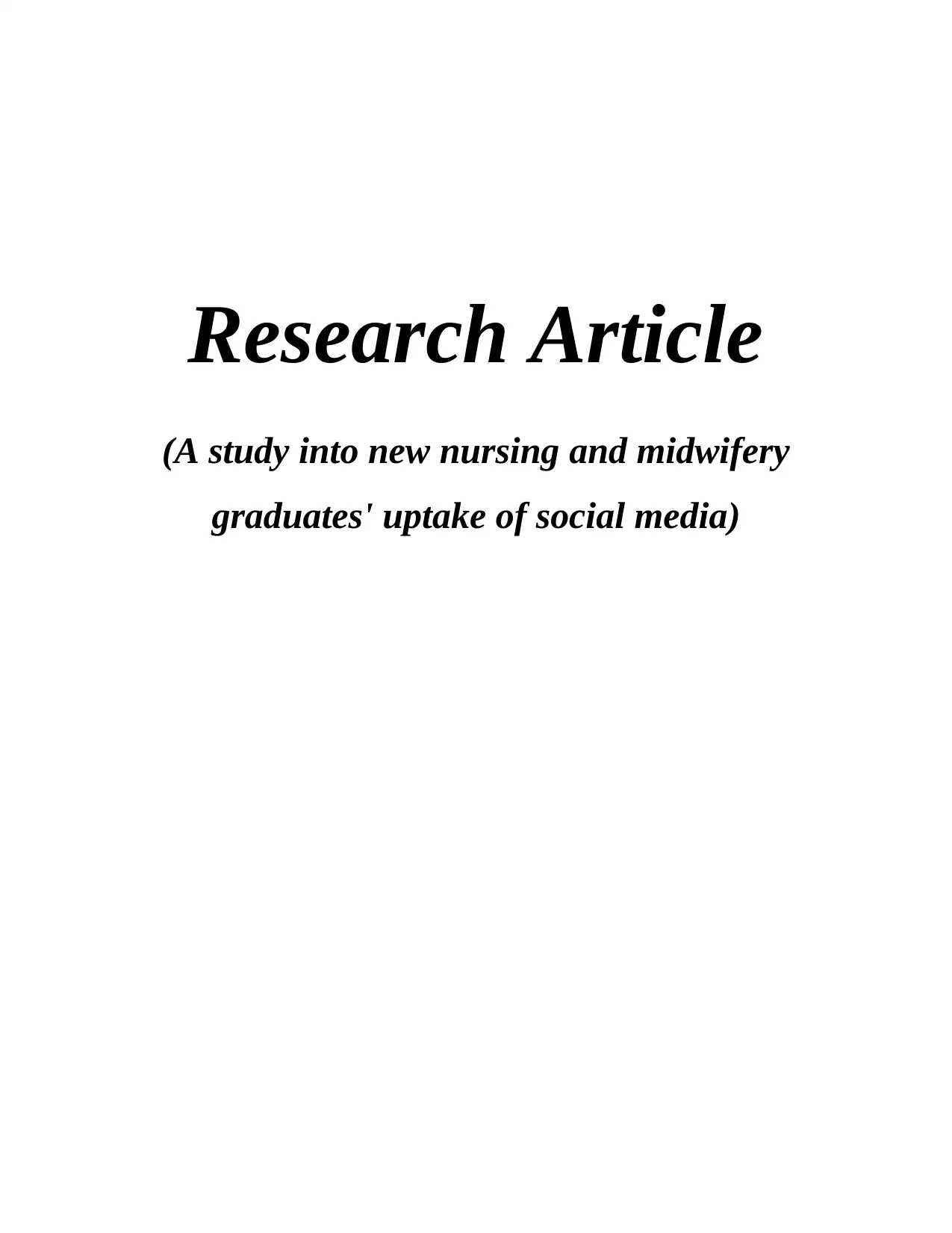
Research Article
(A study into new nursing and midwifery
graduates' uptake of social media)
(A study into new nursing and midwifery
graduates' uptake of social media)
Paraphrase This Document
Need a fresh take? Get an instant paraphrase of this document with our AI Paraphraser
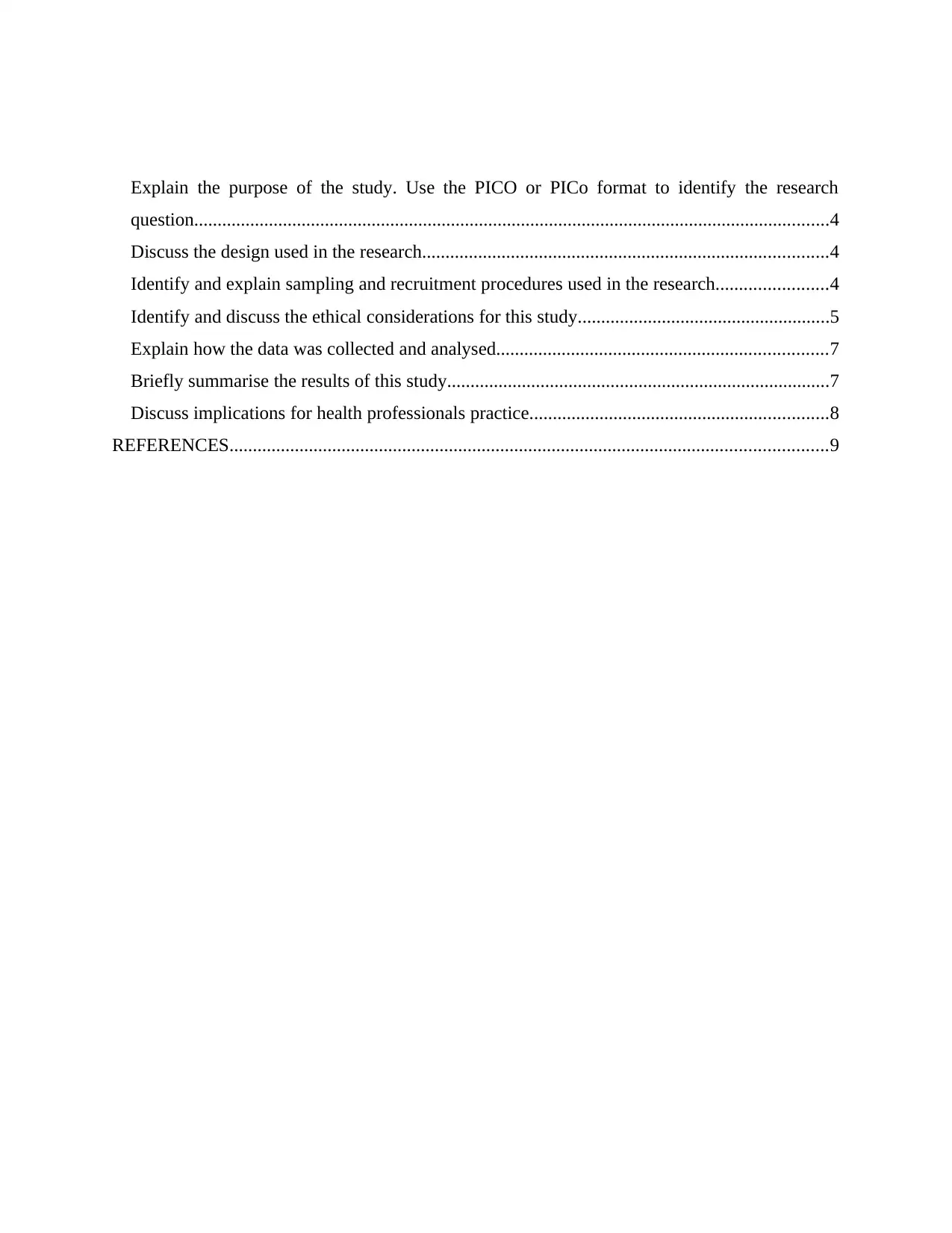
Explain the purpose of the study. Use the PICO or PICo format to identify the research
question........................................................................................................................................4
Discuss the design used in the research.......................................................................................4
Identify and explain sampling and recruitment procedures used in the research........................4
Identify and discuss the ethical considerations for this study......................................................5
Explain how the data was collected and analysed.......................................................................7
Briefly summarise the results of this study..................................................................................7
Discuss implications for health professionals practice................................................................8
REFERENCES................................................................................................................................9
question........................................................................................................................................4
Discuss the design used in the research.......................................................................................4
Identify and explain sampling and recruitment procedures used in the research........................4
Identify and discuss the ethical considerations for this study......................................................5
Explain how the data was collected and analysed.......................................................................7
Briefly summarise the results of this study..................................................................................7
Discuss implications for health professionals practice................................................................8
REFERENCES................................................................................................................................9

Specific critique area Answer
⊘ This is a preview!⊘
Do you want full access?
Subscribe today to unlock all pages.

Trusted by 1+ million students worldwide
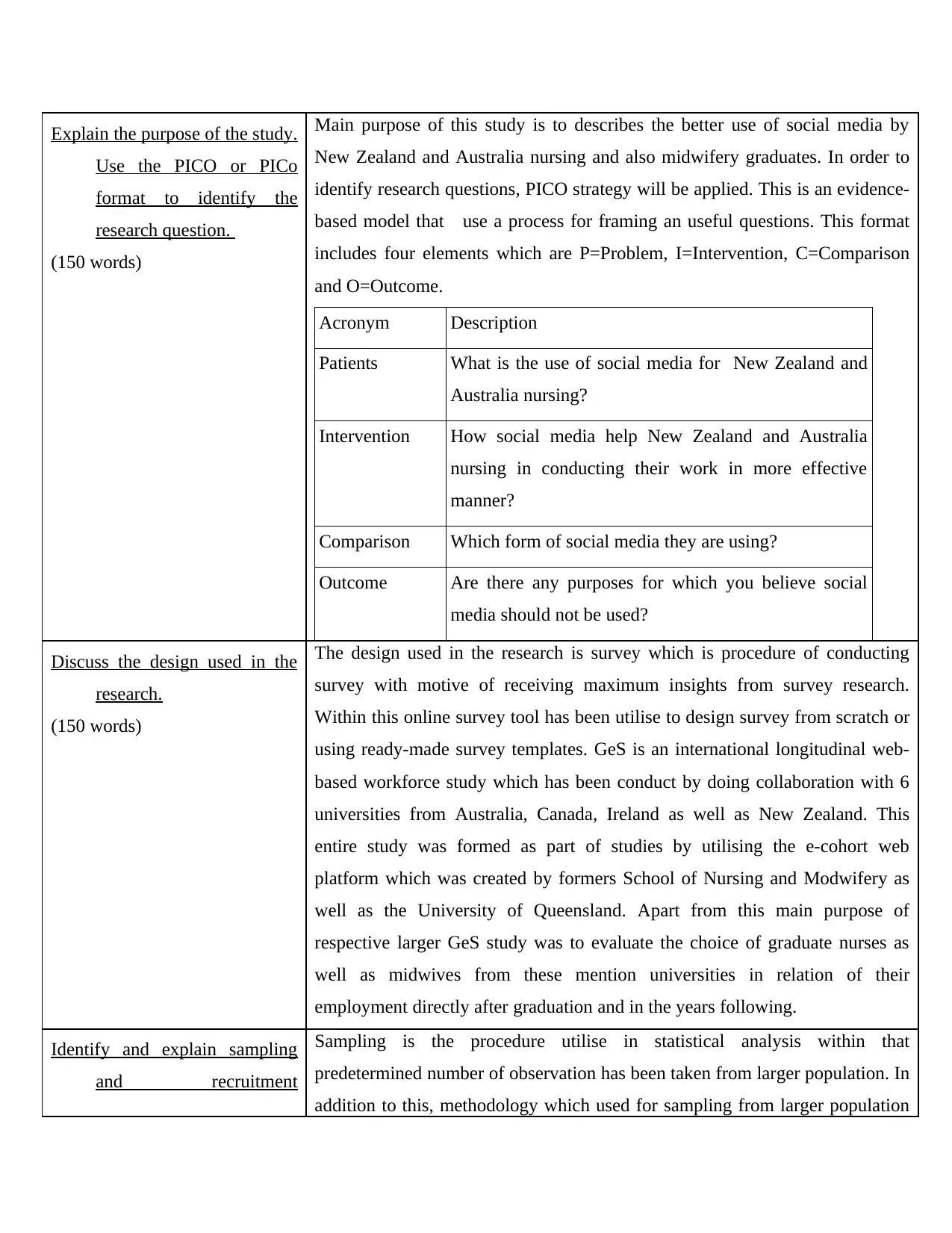
Explain the purpose of the study.
Use the PICO or PICo
format to identify the
research question.
(150 words)
Main purpose of this study is to describes the better use of social media by
New Zealand and Australia nursing and also midwifery graduates. In order to
identify research questions, PICO strategy will be applied. This is an evidence-
based model that use a process for framing an useful questions. This format
includes four elements which are P=Problem, I=Intervention, C=Comparison
and O=Outcome.
Acronym Description
Patients What is the use of social media for New Zealand and
Australia nursing?
Intervention How social media help New Zealand and Australia
nursing in conducting their work in more effective
manner?
Comparison Which form of social media they are using?
Outcome Are there any purposes for which you believe social
media should not be used?
Discuss the design used in the
research.
(150 words)
The design used in the research is survey which is procedure of conducting
survey with motive of receiving maximum insights from survey research.
Within this online survey tool has been utilise to design survey from scratch or
using ready-made survey templates. GeS is an international longitudinal web-
based workforce study which has been conduct by doing collaboration with 6
universities from Australia, Canada, Ireland as well as New Zealand. This
entire study was formed as part of studies by utilising the e-cohort web
platform which was created by formers School of Nursing and Modwifery as
well as the University of Queensland. Apart from this main purpose of
respective larger GeS study was to evaluate the choice of graduate nurses as
well as midwives from these mention universities in relation of their
employment directly after graduation and in the years following.
Identify and explain sampling
and recruitment
Sampling is the procedure utilise in statistical analysis within that
predetermined number of observation has been taken from larger population. In
addition to this, methodology which used for sampling from larger population
Use the PICO or PICo
format to identify the
research question.
(150 words)
Main purpose of this study is to describes the better use of social media by
New Zealand and Australia nursing and also midwifery graduates. In order to
identify research questions, PICO strategy will be applied. This is an evidence-
based model that use a process for framing an useful questions. This format
includes four elements which are P=Problem, I=Intervention, C=Comparison
and O=Outcome.
Acronym Description
Patients What is the use of social media for New Zealand and
Australia nursing?
Intervention How social media help New Zealand and Australia
nursing in conducting their work in more effective
manner?
Comparison Which form of social media they are using?
Outcome Are there any purposes for which you believe social
media should not be used?
Discuss the design used in the
research.
(150 words)
The design used in the research is survey which is procedure of conducting
survey with motive of receiving maximum insights from survey research.
Within this online survey tool has been utilise to design survey from scratch or
using ready-made survey templates. GeS is an international longitudinal web-
based workforce study which has been conduct by doing collaboration with 6
universities from Australia, Canada, Ireland as well as New Zealand. This
entire study was formed as part of studies by utilising the e-cohort web
platform which was created by formers School of Nursing and Modwifery as
well as the University of Queensland. Apart from this main purpose of
respective larger GeS study was to evaluate the choice of graduate nurses as
well as midwives from these mention universities in relation of their
employment directly after graduation and in the years following.
Identify and explain sampling
and recruitment
Sampling is the procedure utilise in statistical analysis within that
predetermined number of observation has been taken from larger population. In
addition to this, methodology which used for sampling from larger population
Paraphrase This Document
Need a fresh take? Get an instant paraphrase of this document with our AI Paraphraser
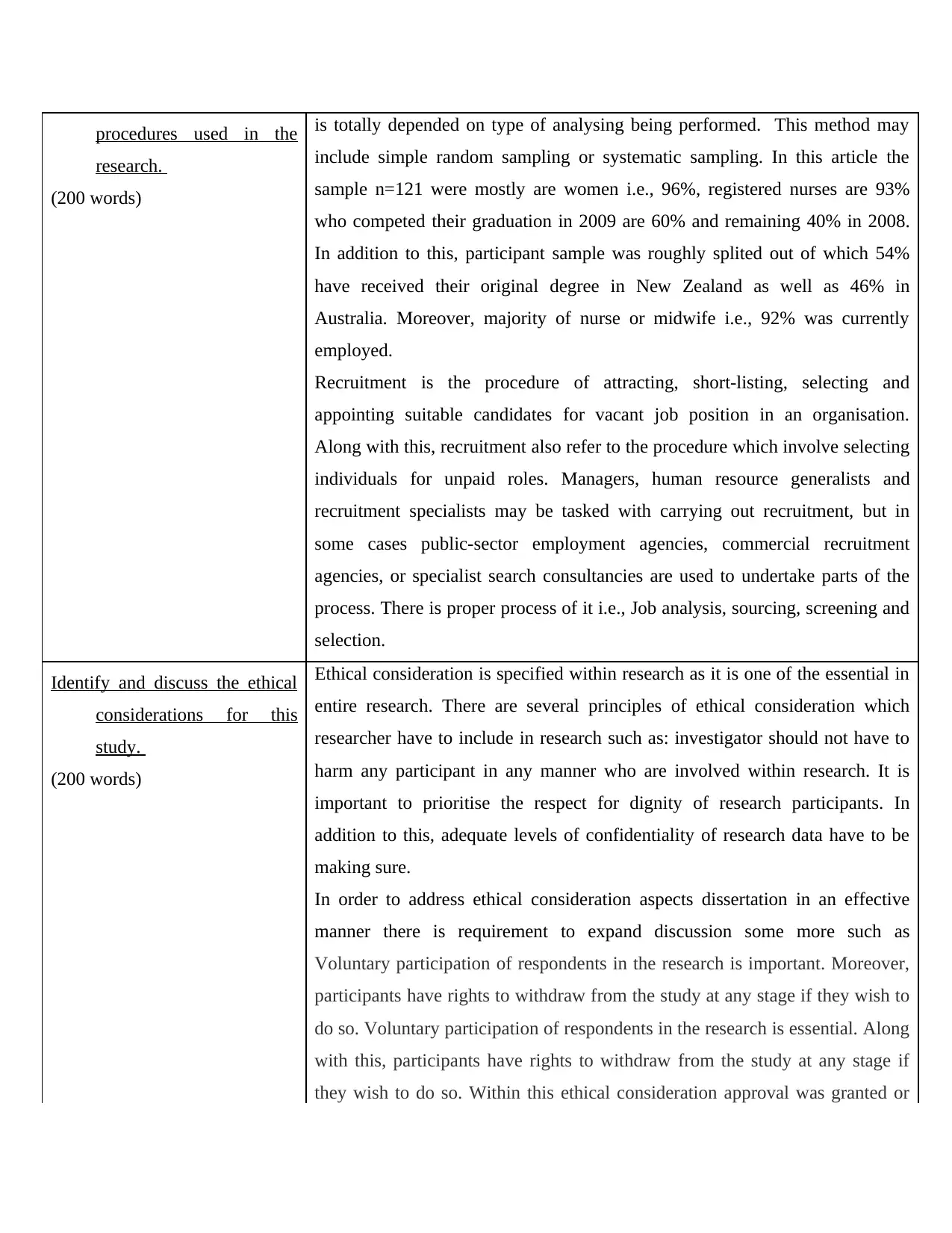
procedures used in the
research.
(200 words)
is totally depended on type of analysing being performed. This method may
include simple random sampling or systematic sampling. In this article the
sample n=121 were mostly are women i.e., 96%, registered nurses are 93%
who competed their graduation in 2009 are 60% and remaining 40% in 2008.
In addition to this, participant sample was roughly splited out of which 54%
have received their original degree in New Zealand as well as 46% in
Australia. Moreover, majority of nurse or midwife i.e., 92% was currently
employed.
Recruitment is the procedure of attracting, short-listing, selecting and
appointing suitable candidates for vacant job position in an organisation.
Along with this, recruitment also refer to the procedure which involve selecting
individuals for unpaid roles. Managers, human resource generalists and
recruitment specialists may be tasked with carrying out recruitment, but in
some cases public-sector employment agencies, commercial recruitment
agencies, or specialist search consultancies are used to undertake parts of the
process. There is proper process of it i.e., Job analysis, sourcing, screening and
selection.
Identify and discuss the ethical
considerations for this
study.
(200 words)
Ethical consideration is specified within research as it is one of the essential in
entire research. There are several principles of ethical consideration which
researcher have to include in research such as: investigator should not have to
harm any participant in any manner who are involved within research. It is
important to prioritise the respect for dignity of research participants. In
addition to this, adequate levels of confidentiality of research data have to be
making sure.
In order to address ethical consideration aspects dissertation in an effective
manner there is requirement to expand discussion some more such as
Voluntary participation of respondents in the research is important. Moreover,
participants have rights to withdraw from the study at any stage if they wish to
do so. Voluntary participation of respondents in the research is essential. Along
with this, participants have rights to withdraw from the study at any stage if
they wish to do so. Within this ethical consideration approval was granted or
research.
(200 words)
is totally depended on type of analysing being performed. This method may
include simple random sampling or systematic sampling. In this article the
sample n=121 were mostly are women i.e., 96%, registered nurses are 93%
who competed their graduation in 2009 are 60% and remaining 40% in 2008.
In addition to this, participant sample was roughly splited out of which 54%
have received their original degree in New Zealand as well as 46% in
Australia. Moreover, majority of nurse or midwife i.e., 92% was currently
employed.
Recruitment is the procedure of attracting, short-listing, selecting and
appointing suitable candidates for vacant job position in an organisation.
Along with this, recruitment also refer to the procedure which involve selecting
individuals for unpaid roles. Managers, human resource generalists and
recruitment specialists may be tasked with carrying out recruitment, but in
some cases public-sector employment agencies, commercial recruitment
agencies, or specialist search consultancies are used to undertake parts of the
process. There is proper process of it i.e., Job analysis, sourcing, screening and
selection.
Identify and discuss the ethical
considerations for this
study.
(200 words)
Ethical consideration is specified within research as it is one of the essential in
entire research. There are several principles of ethical consideration which
researcher have to include in research such as: investigator should not have to
harm any participant in any manner who are involved within research. It is
important to prioritise the respect for dignity of research participants. In
addition to this, adequate levels of confidentiality of research data have to be
making sure.
In order to address ethical consideration aspects dissertation in an effective
manner there is requirement to expand discussion some more such as
Voluntary participation of respondents in the research is important. Moreover,
participants have rights to withdraw from the study at any stage if they wish to
do so. Voluntary participation of respondents in the research is essential. Along
with this, participants have rights to withdraw from the study at any stage if
they wish to do so. Within this ethical consideration approval was granted or
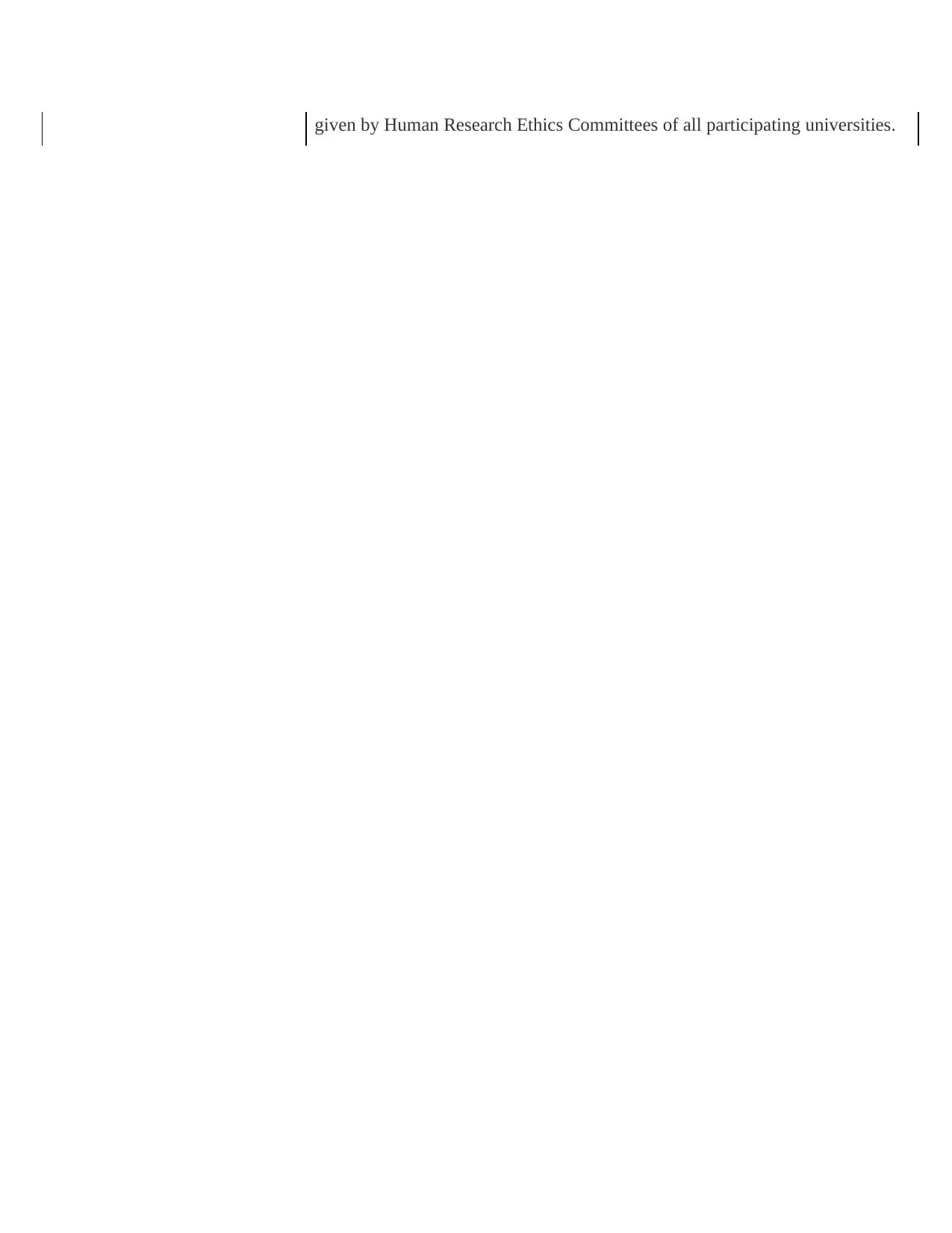
given by Human Research Ethics Committees of all participating universities.
⊘ This is a preview!⊘
Do you want full access?
Subscribe today to unlock all pages.

Trusted by 1+ million students worldwide
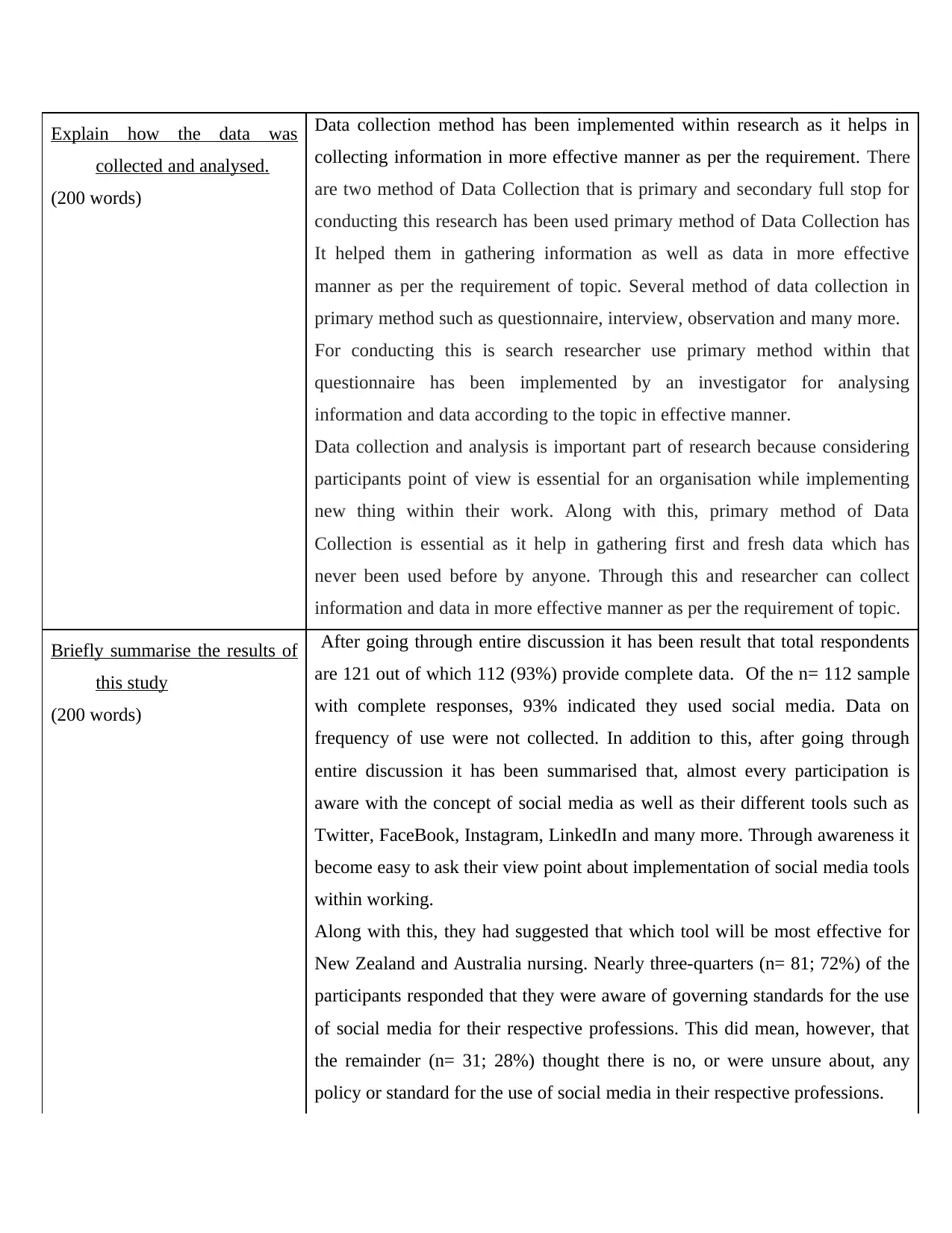
Explain how the data was
collected and analysed.
(200 words)
Data collection method has been implemented within research as it helps in
collecting information in more effective manner as per the requirement. There
are two method of Data Collection that is primary and secondary full stop for
conducting this research has been used primary method of Data Collection has
It helped them in gathering information as well as data in more effective
manner as per the requirement of topic. Several method of data collection in
primary method such as questionnaire, interview, observation and many more.
For conducting this is search researcher use primary method within that
questionnaire has been implemented by an investigator for analysing
information and data according to the topic in effective manner.
Data collection and analysis is important part of research because considering
participants point of view is essential for an organisation while implementing
new thing within their work. Along with this, primary method of Data
Collection is essential as it help in gathering first and fresh data which has
never been used before by anyone. Through this and researcher can collect
information and data in more effective manner as per the requirement of topic.
Briefly summarise the results of
this study
(200 words)
After going through entire discussion it has been result that total respondents
are 121 out of which 112 (93%) provide complete data. Of the n= 112 sample
with complete responses, 93% indicated they used social media. Data on
frequency of use were not collected. In addition to this, after going through
entire discussion it has been summarised that, almost every participation is
aware with the concept of social media as well as their different tools such as
Twitter, FaceBook, Instagram, LinkedIn and many more. Through awareness it
become easy to ask their view point about implementation of social media tools
within working.
Along with this, they had suggested that which tool will be most effective for
New Zealand and Australia nursing. Nearly three-quarters (n= 81; 72%) of the
participants responded that they were aware of governing standards for the use
of social media for their respective professions. This did mean, however, that
the remainder (n= 31; 28%) thought there is no, or were unsure about, any
policy or standard for the use of social media in their respective professions.
collected and analysed.
(200 words)
Data collection method has been implemented within research as it helps in
collecting information in more effective manner as per the requirement. There
are two method of Data Collection that is primary and secondary full stop for
conducting this research has been used primary method of Data Collection has
It helped them in gathering information as well as data in more effective
manner as per the requirement of topic. Several method of data collection in
primary method such as questionnaire, interview, observation and many more.
For conducting this is search researcher use primary method within that
questionnaire has been implemented by an investigator for analysing
information and data according to the topic in effective manner.
Data collection and analysis is important part of research because considering
participants point of view is essential for an organisation while implementing
new thing within their work. Along with this, primary method of Data
Collection is essential as it help in gathering first and fresh data which has
never been used before by anyone. Through this and researcher can collect
information and data in more effective manner as per the requirement of topic.
Briefly summarise the results of
this study
(200 words)
After going through entire discussion it has been result that total respondents
are 121 out of which 112 (93%) provide complete data. Of the n= 112 sample
with complete responses, 93% indicated they used social media. Data on
frequency of use were not collected. In addition to this, after going through
entire discussion it has been summarised that, almost every participation is
aware with the concept of social media as well as their different tools such as
Twitter, FaceBook, Instagram, LinkedIn and many more. Through awareness it
become easy to ask their view point about implementation of social media tools
within working.
Along with this, they had suggested that which tool will be most effective for
New Zealand and Australia nursing. Nearly three-quarters (n= 81; 72%) of the
participants responded that they were aware of governing standards for the use
of social media for their respective professions. This did mean, however, that
the remainder (n= 31; 28%) thought there is no, or were unsure about, any
policy or standard for the use of social media in their respective professions.
Paraphrase This Document
Need a fresh take? Get an instant paraphrase of this document with our AI Paraphraser
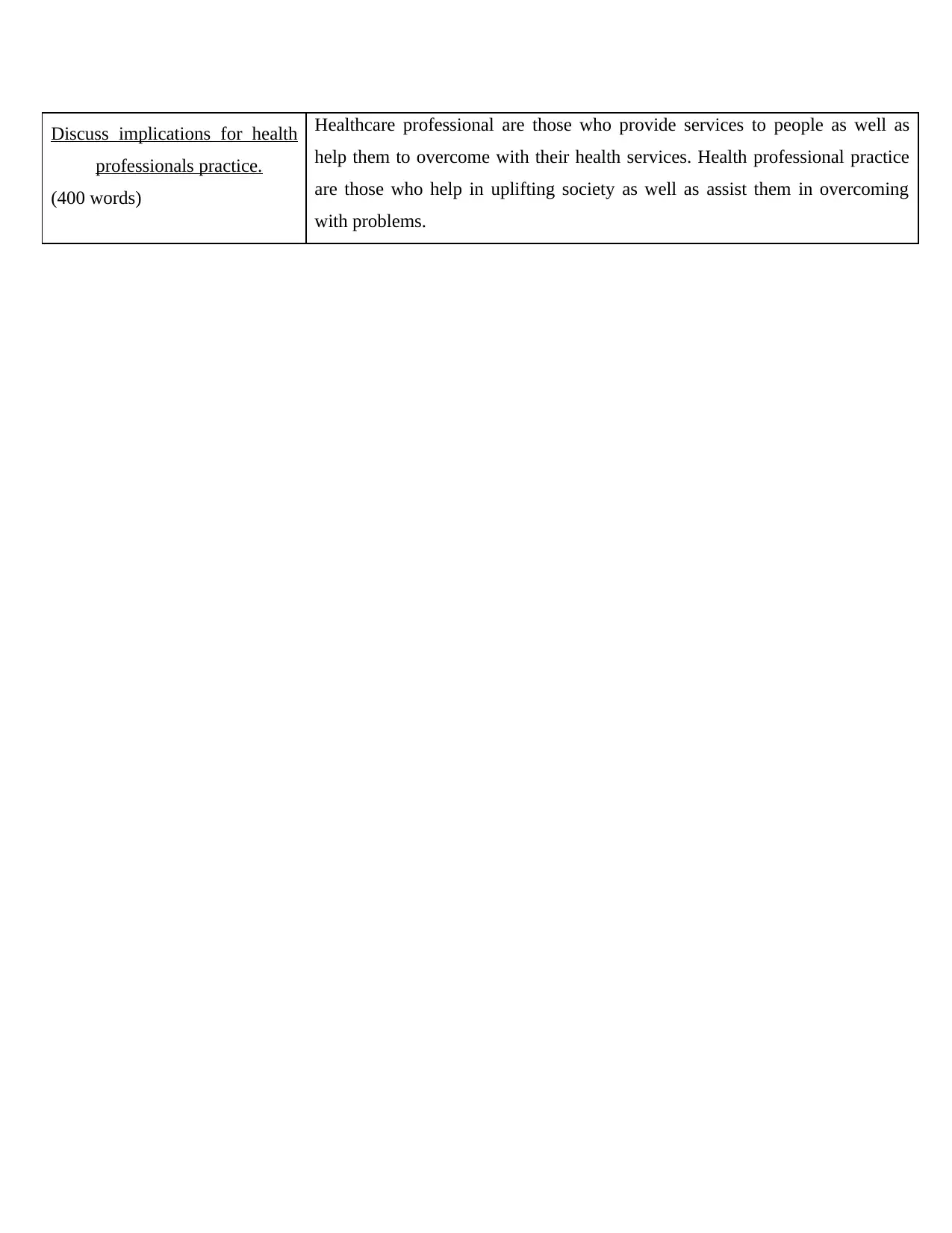
Discuss implications for health
professionals practice.
(400 words)
Healthcare professional are those who provide services to people as well as
help them to overcome with their health services. Health professional practice
are those who help in uplifting society as well as assist them in overcoming
with problems.
professionals practice.
(400 words)
Healthcare professional are those who provide services to people as well as
help them to overcome with their health services. Health professional practice
are those who help in uplifting society as well as assist them in overcoming
with problems.
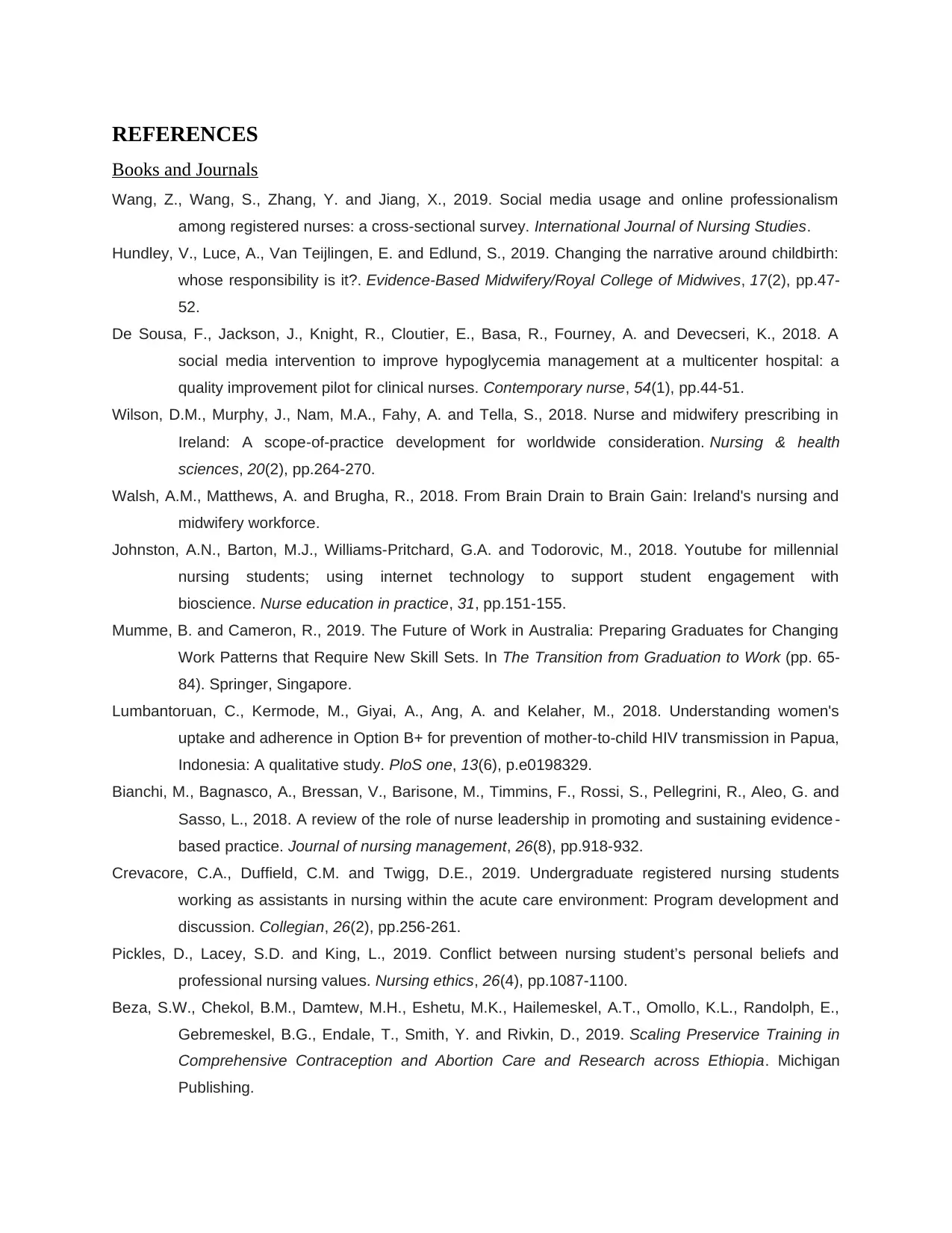
REFERENCES
Books and Journals
Wang, Z., Wang, S., Zhang, Y. and Jiang, X., 2019. Social media usage and online professionalism
among registered nurses: a cross-sectional survey. International Journal of Nursing Studies.
Hundley, V., Luce, A., Van Teijlingen, E. and Edlund, S., 2019. Changing the narrative around childbirth:
whose responsibility is it?. Evidence-Based Midwifery/Royal College of Midwives, 17(2), pp.47-
52.
De Sousa, F., Jackson, J., Knight, R., Cloutier, E., Basa, R., Fourney, A. and Devecseri, K., 2018. A
social media intervention to improve hypoglycemia management at a multicenter hospital: a
quality improvement pilot for clinical nurses. Contemporary nurse, 54(1), pp.44-51.
Wilson, D.M., Murphy, J., Nam, M.A., Fahy, A. and Tella, S., 2018. Nurse and midwifery prescribing in
Ireland: A scope‐of‐practice development for worldwide consideration. Nursing & health
sciences, 20(2), pp.264-270.
Walsh, A.M., Matthews, A. and Brugha, R., 2018. From Brain Drain to Brain Gain: Ireland's nursing and
midwifery workforce.
Johnston, A.N., Barton, M.J., Williams-Pritchard, G.A. and Todorovic, M., 2018. Youtube for millennial
nursing students; using internet technology to support student engagement with
bioscience. Nurse education in practice, 31, pp.151-155.
Mumme, B. and Cameron, R., 2019. The Future of Work in Australia: Preparing Graduates for Changing
Work Patterns that Require New Skill Sets. In The Transition from Graduation to Work (pp. 65-
84). Springer, Singapore.
Lumbantoruan, C., Kermode, M., Giyai, A., Ang, A. and Kelaher, M., 2018. Understanding women's
uptake and adherence in Option B+ for prevention of mother-to-child HIV transmission in Papua,
Indonesia: A qualitative study. PloS one, 13(6), p.e0198329.
Bianchi, M., Bagnasco, A., Bressan, V., Barisone, M., Timmins, F., Rossi, S., Pellegrini, R., Aleo, G. and
Sasso, L., 2018. A review of the role of nurse leadership in promoting and sustaining evidence ‐
based practice. Journal of nursing management, 26(8), pp.918-932.
Crevacore, C.A., Duffield, C.M. and Twigg, D.E., 2019. Undergraduate registered nursing students
working as assistants in nursing within the acute care environment: Program development and
discussion. Collegian, 26(2), pp.256-261.
Pickles, D., Lacey, S.D. and King, L., 2019. Conflict between nursing student’s personal beliefs and
professional nursing values. Nursing ethics, 26(4), pp.1087-1100.
Beza, S.W., Chekol, B.M., Damtew, M.H., Eshetu, M.K., Hailemeskel, A.T., Omollo, K.L., Randolph, E.,
Gebremeskel, B.G., Endale, T., Smith, Y. and Rivkin, D., 2019. Scaling Preservice Training in
Comprehensive Contraception and Abortion Care and Research across Ethiopia. Michigan
Publishing.
Books and Journals
Wang, Z., Wang, S., Zhang, Y. and Jiang, X., 2019. Social media usage and online professionalism
among registered nurses: a cross-sectional survey. International Journal of Nursing Studies.
Hundley, V., Luce, A., Van Teijlingen, E. and Edlund, S., 2019. Changing the narrative around childbirth:
whose responsibility is it?. Evidence-Based Midwifery/Royal College of Midwives, 17(2), pp.47-
52.
De Sousa, F., Jackson, J., Knight, R., Cloutier, E., Basa, R., Fourney, A. and Devecseri, K., 2018. A
social media intervention to improve hypoglycemia management at a multicenter hospital: a
quality improvement pilot for clinical nurses. Contemporary nurse, 54(1), pp.44-51.
Wilson, D.M., Murphy, J., Nam, M.A., Fahy, A. and Tella, S., 2018. Nurse and midwifery prescribing in
Ireland: A scope‐of‐practice development for worldwide consideration. Nursing & health
sciences, 20(2), pp.264-270.
Walsh, A.M., Matthews, A. and Brugha, R., 2018. From Brain Drain to Brain Gain: Ireland's nursing and
midwifery workforce.
Johnston, A.N., Barton, M.J., Williams-Pritchard, G.A. and Todorovic, M., 2018. Youtube for millennial
nursing students; using internet technology to support student engagement with
bioscience. Nurse education in practice, 31, pp.151-155.
Mumme, B. and Cameron, R., 2019. The Future of Work in Australia: Preparing Graduates for Changing
Work Patterns that Require New Skill Sets. In The Transition from Graduation to Work (pp. 65-
84). Springer, Singapore.
Lumbantoruan, C., Kermode, M., Giyai, A., Ang, A. and Kelaher, M., 2018. Understanding women's
uptake and adherence in Option B+ for prevention of mother-to-child HIV transmission in Papua,
Indonesia: A qualitative study. PloS one, 13(6), p.e0198329.
Bianchi, M., Bagnasco, A., Bressan, V., Barisone, M., Timmins, F., Rossi, S., Pellegrini, R., Aleo, G. and
Sasso, L., 2018. A review of the role of nurse leadership in promoting and sustaining evidence ‐
based practice. Journal of nursing management, 26(8), pp.918-932.
Crevacore, C.A., Duffield, C.M. and Twigg, D.E., 2019. Undergraduate registered nursing students
working as assistants in nursing within the acute care environment: Program development and
discussion. Collegian, 26(2), pp.256-261.
Pickles, D., Lacey, S.D. and King, L., 2019. Conflict between nursing student’s personal beliefs and
professional nursing values. Nursing ethics, 26(4), pp.1087-1100.
Beza, S.W., Chekol, B.M., Damtew, M.H., Eshetu, M.K., Hailemeskel, A.T., Omollo, K.L., Randolph, E.,
Gebremeskel, B.G., Endale, T., Smith, Y. and Rivkin, D., 2019. Scaling Preservice Training in
Comprehensive Contraception and Abortion Care and Research across Ethiopia. Michigan
Publishing.
⊘ This is a preview!⊘
Do you want full access?
Subscribe today to unlock all pages.

Trusted by 1+ million students worldwide
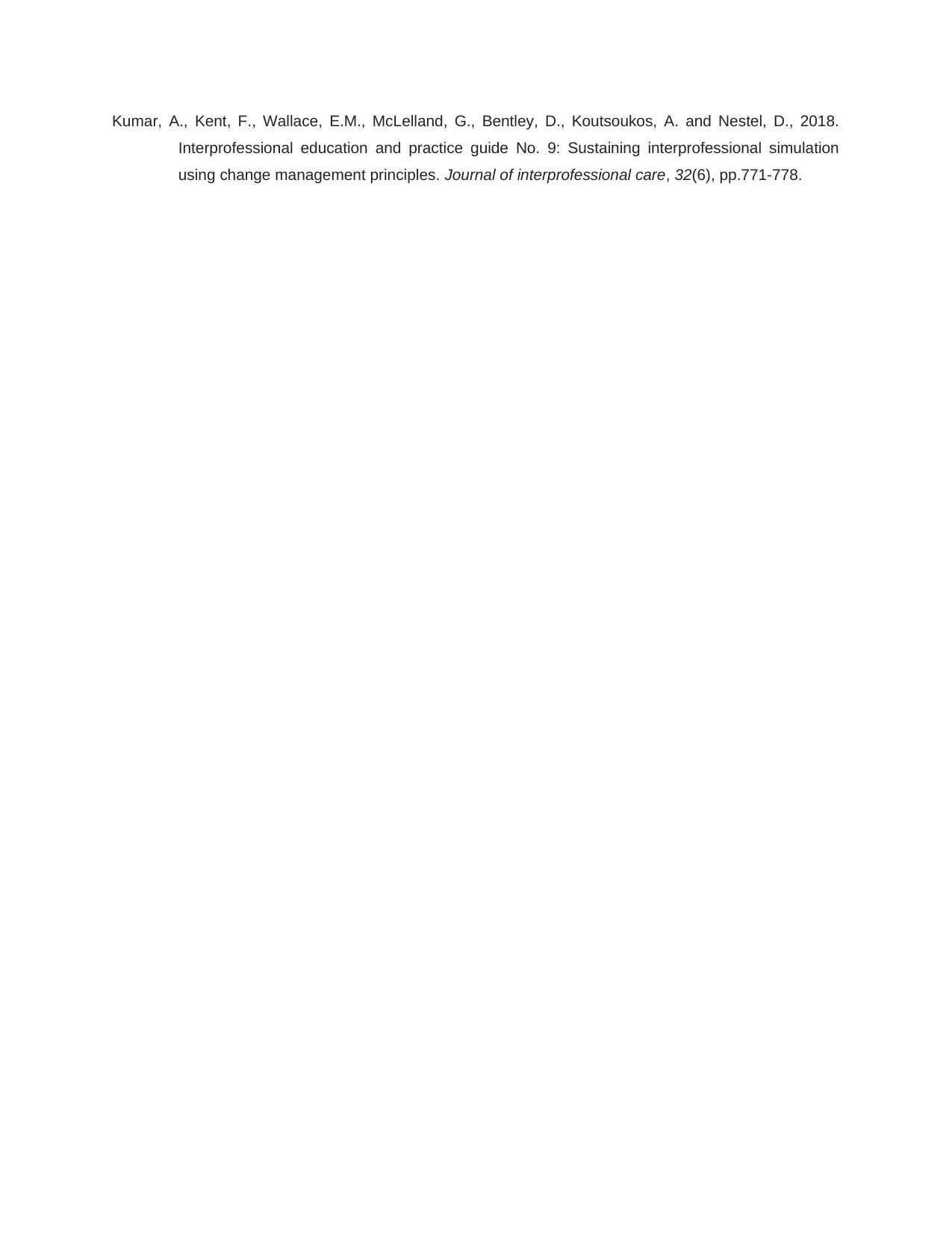
Kumar, A., Kent, F., Wallace, E.M., McLelland, G., Bentley, D., Koutsoukos, A. and Nestel, D., 2018.
Interprofessional education and practice guide No. 9: Sustaining interprofessional simulation
using change management principles. Journal of interprofessional care, 32(6), pp.771-778.
Interprofessional education and practice guide No. 9: Sustaining interprofessional simulation
using change management principles. Journal of interprofessional care, 32(6), pp.771-778.
1 out of 10
Related Documents
Your All-in-One AI-Powered Toolkit for Academic Success.
+13062052269
info@desklib.com
Available 24*7 on WhatsApp / Email
![[object Object]](/_next/static/media/star-bottom.7253800d.svg)
Unlock your academic potential
Copyright © 2020–2025 A2Z Services. All Rights Reserved. Developed and managed by ZUCOL.





